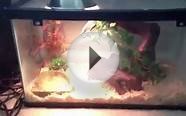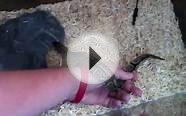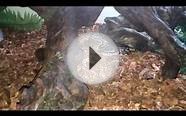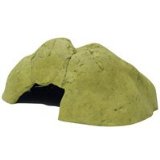Ball Python tank setup
Creating a ball python cage setup is the first step to proper snake care. After you read this article, you'll learn how important the cage setup is to the overall health of your ball python. We will discuss all of the key components of a proper habitat - heating, lighting, substrate and more. But first, let's talk about the cage itself.
Choosing a Cage for Your Ball Python
Ball pythons are fairly simple to keep in captivity. They don't have any unusual care requirements, and they don't get very big. As a result, there are many different types of enclosures you can use to create a ball python cage setup.

Terminology note: In this article, I'll be using the terms cage, enclosure and habitat. Cage and enclosure basically mean the same thing - this is the plastic or glass box where your ball python resides. The habitat is a broader term includes the cage, the substrate, the furniture, heating and lighting, etc.
When you set up your ball python cage, you will be able to choose from several different caging options. Here's a quick rundown:
- Glass cages - You're probably most familiar with this cage option. This would be the all-glass terrarium that's commonly sold in pet stores. You can make a suitable ball python setup with a glass terrarium. They are fairly cheap, and they come in a wide variety of sizes.
- Plastic cages - The reptile industry has come a long way over the years. This is evident in the wide variety of plastic cages that are available for reptiles. Many of these products are an excellent choice for your ball python cage setup, because they do a good job holding heat and humidity. They also make the snake feel more secure in its environment, because the top, bottom and sides are non-transparent. Some plastic cages have light and heating built in, while others have spaces where you can add your own heat and lighting fixtures.
- Rack systems - You can also design your ball python cage setup around a rack system. This is where one cage is stacked on top of another. This is a common setup for people who keep a lot of snakes, such as breeders. But if you're buying your first pet snake, you don't really need a rack system.
- Homemade cages - Some keepers choose to build their own snake cages. I do not recommend this for a beginner. In order to build your own ball python cage, you need to know a lot about snakes (and what it takes to keep them healthy). This comes from years of experience. Professionally built reptile cages are fairly affordable these days, especially when you consider how long they last. You could buy a nice plastic cage for $200 - $300, and it might last 20 years or more. The same cannot be said about a homemade cage.
That covers the cage itself. Now let's talk about the other items that need to go into the ball python cage setup. Let's talk about heating, lighting, hides and substrate.
You might also like




|
Zoo Med Economy Analog Dual Thermometer and Humidity Gauge Pet Products (Zoo Med Laboratories)
|




|
Zoo Med ReptiTherm® Under Tank Heater, Medium Pet Products (Zoo Med Laboratories)
|

|
Exo Terra Reptile Cave, Extra Large Pet Products (Exo Terra)
|






